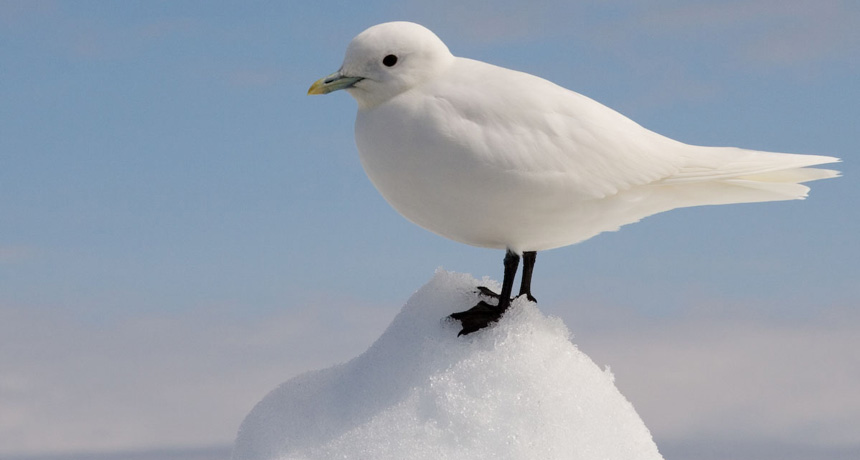Year in review: Sea ice loss will shake up ecosystems

In a better world, it would be the big news of the year just to report that Arctic sea ice shrank to 4.14 million square kilometers this summer, well below the 1981–2010 average of 6.22 million square kilometers (SN Online: 9/19/16). But in this world of changing climate, extreme summer ice loss has become almost expected. More novel in 2016 were glimpses of the complex biological consequences of melting at the poles and the opening of Arctic passageways, talked about for at least a decade and now well under way.
With top-of-the-world trade and tourist shortcuts opening, less ice means more travel. Europe-to-Asia shipping routes will typically shorten by about 10 days by midcentury, a report in Geophysical Research Letters predicted. Hopes for Northwest Passage routes obsessed (and killed) explorers in previous centuries, but in 2016, the thousand-passenger cruise ship Crystal Serenity offered the first megascale tourist trip from Alaska to New York with fine dining, casino gambling and an escort icebreaker vessel.
Biologists are delving into consequences for organisms other than human tourists — or the much-discussed polar bear. “There’s been a marked shift in the research community,” says climate change ecologist Eric Post of the University of California, Davis. There’s new interest in considering more than just species that dwell on sea ice, with researchers looking for the less direct effects of declining ice.
In the February Global Change Biology, eight scientists issued a call for observations of what could be early signs of faunal exchange: the mingling of Atlantic and Pacific species. One possible indicator is the sighting of gray whales off the coast of Namibia and also off Israel, even though that species went extinct in the Atlantic two centuries ago. These whales feed by snouting around in soft ocean bottoms, adding another predator to the system but also creating new habitat opportunities for some creatures (SN: 1/23/16, p. 14).
Since the call was published, biodiversity scientist Seabird McKeon of Colby College in Waterville, Maine, has heard new reports, such as a sighting of an ancient murrelet off the coast of Maine. It’s not the first wrong-coast report for the bird, which typically resides in the northern Pacific, but repeat sightings could be important, too. “What I think we’re seeing is not just new species coming across, but also perhaps an increased chance of survival and reproduction if more come over,” McKeon says. He is hoping to get new data from the online Encyclopedia of Life’s upcoming Fresh Data system, which connects scientists to people reporting nature observations.
For terrestrial northerners, melting ice often means loss of mobility. Peary caribou on the 36,000 or more islands of Canada’s northern archipelago occasionally use ice bridges to travel to new territories and mix genes with other populations. Yet ice losses since 1979 have
made it some 15 percent harder
to find traveling paths, researchers reported in September inBiology Letters
(
SN: 10/29/16, p. 8
).
Even some plants such as dwarf birch probably travel by ice, scientists also reported in September in Biology Letters. Reconstructing long-ago sea ice extent and plant colonization dates suggests that seeds hitchhiked on slowly creeping frozen conveyors around northern Europe to colonize new territory at the end of the Ice Age. Losing ice roads could lead to tattered, disconnected populations as recolonization becomes less likely. Yet, there are pluses and minuses, says Post, who is helping to develop a package of scientific articles for Biology Letters on the biological effects of sea ice loss. Reseeding populations after a wipeout could be more difficult with tattered ice, but for the highly specialized and vulnerable plants very far north, the loss of sea ice could slow the arrival of invasive species that threaten the natives.
The minimum summer sea ice extent since 1979 has declined by about 87,000 square kilometers per year, equivalent to an area more than three times the size of New Jersey disappearing annually, as Post has put it. The September 2016 sea ice minimum didn’t break a record, as some had expected it might. It tied for second worst, behind the 2012 minimum, and roughly equaled the 2007 minimum. 2016 did set a new record low for winter Arctic ice extent (SN Online: 3/28/16).
Sea ice changes reverberate through the ecosystem. Ice melting cues the springtime phytoplankton blooms that feed copepods and other tiny marine grazers. The grazers feed their predators and, in turn, the predators of those predators. In years when spring warming brings an early ice retreat, the phyto-plankton bloom is not a huge, rich burst. It favors smaller grazing zooplankton that don’t fuel as much of a boom in their predators, marine ecologist Martin Renner of Homer, Alaska, and colleagues reported in a paper for the Biology Letters special collection.
Tracing the effects of shrinking ice through these grazers to fish to seabirds revealed a tangled web of ups and downs and shifting foraging grounds. In the end, Renner and colleagues predict “a very different eastern Bering Sea ecosystem and fishery than we know today.” And that may be far from the only sea change in the far north.